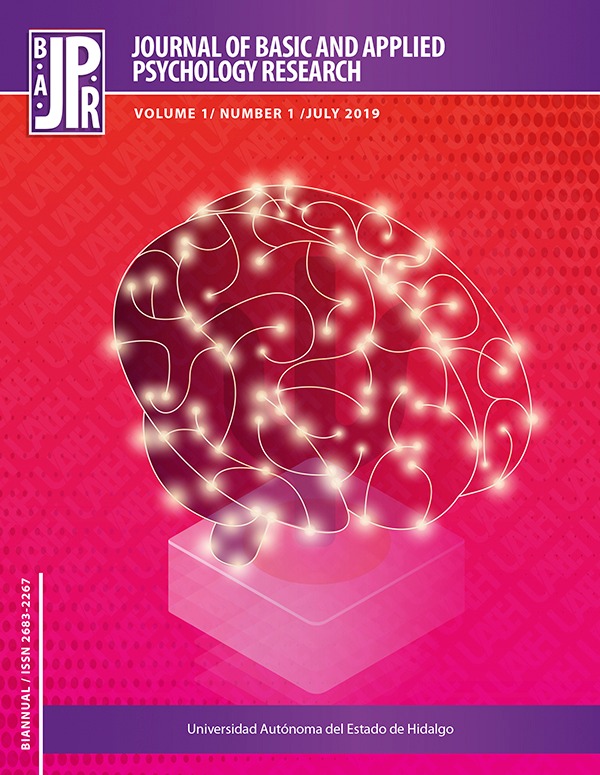Instrumental Activities and Quality of LIfe in Older Adults
DOI:
https://doi.org/10.29057/jbapr.v1i1.4066Keywords:
Instrumental activities, quality of life, older people, well-beingAbstract
According to The Activity Theory, the elderly who are involved and participate in more activities than the rest of this population reflect higher levels of satisfaction. These activities must be productive in concordance to the role that the older people assume within their context, in order to strengthen their well-being. Thus, this paper aims to describe the relationship between the frequency and satisfaction of the IADL, and the perception of Quality of life (QOL). Therefore, the design of this paper is non-experimental with a non-probabilistic purposive sample of 16 volunteer older adults who live in Hidalgo. The volunteers signed an informed consent form prior to the application of the Quality of Life questionnaire, older people version (WHOQOL-old) and a survey through an interview about their participation in different productive instrumental activities. The present findings show that the perception of QOL it is not fully determined by the frequency with older people perform those activities. It is concluded that, in older adults, is important both the frequency and satisfaction whit the instrumental activities, because of there are equally important, although participation in productive activities may have an incidence, it is necessary takes into accountant the value or the satisfaction experienced by the elderly during their perform because this influence their perception of well-being
Downloads
Publication Facts
Reviewer profiles N/A
Author statements
Indexed in
- Academic society
- N/A
- Publisher
- Universidad Autónoma del Estado de Hidalgo
References
Acuña, M. R. (31 de enero de 2019). Ocuparse y prepararse para la vejez. El Independiente de Hidalgo, 10(3425), 21. Recuperado de https://www.elindependientedehidalgo.com.mx/ocuparse-y-prepararse-para-la-vejez/
Aristizábal-Vallejo, N. (2013). Introducción. En: Aristizabal-Vallejo, N., Bernal-Aristizabal, J., Bernal, R., & Cabrera, J. Envejecimiento activo. Un proceso de todos y para todas. (pp. 3-8). Colombia: Maestros de la Supervivencia.
Dulce-Ruiz, E. (Marzo 2000). Envejecimiento, calidad de vida y violencia intrafamiliar. Sesión de cartel presentado en el 5o. Congreso Iberoamericano de Psicología de la Salud. Cartagena: Colombia.
Durán, D.M., Orbegoz, L.J., Uribe-Rodríguez, A.F., & Uribe, J.M. (junio, 2008). Integración social y habilidades funcionales en adultos mayores. Universitas Psychologica, 7(1), 263-270). Recuperado de http://www.scielo.org.co/scielo.php?pid=S1657-92672008000100019&script=sci_abstract&tlng=es
Farquhar, M. (1995). Elderly people’s definitions of quality of life. Social, Science & Medicine, 41(19), 1439-1446. Recuperado de https://www.sciencedirect.com/science/article/pii/027795369500117P
Fernández-Ballesteros, R. (2002). Envejecimiento satisfactorio. En: Zarco, D. & Martínez, J. (Ed.) Corazón, cerebro y envejecimiento. (pp. 35-53), España: Tricastela.
González-Celis, A. & Gómez-Benito, J. (2013). Quality of life in the elderly: Psychometric properties of the WHOQOL-OLD module in Mexico. Health, 5(12), 110-116. Doi: http://dx.doi.org/10.4236/health.2013.512A015. Recuperado de https://www.scirp.org/journal/PaperInformation.aspx?PaperID=41221
Hernández, R., Fernández, C., & Baptista, P. (2010). Metodología de la Investigación. México: Mcgraw-HILL / Interamericana.
Havighurst, R. (1961). Successful aging. The Gerontologist, (1), 8-13. doi.org/10.1093/geront/1.1.8
Instituto Nacional de Estadística y Geografía (febrero, 2015). Encuesta Intercensal. Recuperado de http://www.beta.inegi.org.mx/programas/intercensal/2015/
Lawton, M. & Brody, E. (1969). Assessment of older people: Self-Maintaining and instrumental activities of daily living. The Gerontologist, 9(3), 179-186. Recuperado de https://doi.org/10.1093/geront/9.3_Part_1.179
Havighurst, R. (1961). Successful aging. The Gerontologist, (1), 8-13. doi.org/10.1093/geront/1.1.8
Instituto Nacional de Estadística y Geografía (febrero, 2015). Encuesta Intercensal. Recuperado de http://www.beta.inegi.org.mx/programas/intercensal/2015/
Lawton, M. & Brody, E. (1969). Assessment of older people: Self-Maintaining and instrumental activities of daily living. The Gerontologist, 9(3), 179-186. Recuperado de https://doi.org/10.1093/geront/9.3_Part_1.179
Mendoza-Núñez, V. & Martínez-Maldonado, M. (2013). Funcionalidad. En Mendoza-Núñez, V., Martínez-Maldonado, M. y Vargas-Guadarrama, L. (Eds.), Envejecimiento activo y saludable. Fundamentos y estrategias desde la gerontología comunitaria. (pp. 351-356). México: UNAM, Facultad de Estudios Superiores Zaragoza.
Oddone, M. (febrero, 2013). Antecedentes teóricos del envejecimiento activo. Informes Envejecimiento en Red, (4), 1-9. ISSN: 2340-266X. Recuperado de http://envejecimiento.csic.es/documentos/documentos/odonne-antecedentes-1.pdf.
Organización de las Naciones Unidas (2015). World population prospects. The 2015 revision. Key findings and advance tables. New York: ONU.
Organización Mundial de la Salud (2002). Envejecimiento Activo: un marco político. Revista Española de Geriatría y Gerontología 37(S2), 74-105, 2011.
Organización Mundial de la Salud (Abril, 2015). Informe Mundial sobre el Envejecimiento y la Salud. Recuperado defile:///C:/Users/Dra.%20Acu%C3%B1a/Downloads/httpapps.who.intirisbitstream1066518646619789240694873_spa.pdf.pdf.
Paredes, Y., Pinzón, E. & Aguirre, D. (2018). Funcionalidad y factores asociados en el adulto mayor de la ciudad de San Juan de Pasto, Colombia. Revistas Ciencias de la Salud, 16(1), 114-128. doi: http://dx.doi.org/10.12804/revistas.urosario.edu.co/revsalud/a6494.
Power, M., Quinn, K., Schimidt, S. & WHOQoL-OLD Group. (2005). Development of the WHOQoL-Old module. Quality of life Research, 14, 2197 – 2214. Recuperado de https://www.ncbi.nlm.nih.gov/pubmed/16328900
Sánchez-Sosa, J. & González-Celis, A. (2005). Evaluación de la calidad de vida desde la perspectiva psicológica. En V. E. Caballo (Coord.): Manual para la evaluación clínica de los trastornos psicológicos: Trastornos de la edad adulta e informes psicológicos (pp. 473-492). Madrid: Pirámide.
Soberana, S., González, A., Moreno, Y. del C. (2009). Funcionalidad en adultos mayores y su calidad de vida. Revista de Especialidades Médico-Quirúrgicas, 14(4), 161-172. Recuperado de https://www.medigraphic.com/cgi-bin/new/resumen.cgi?IDARTICULO=30184
Verena, H. (Junio, 2003). The relation between everyday activities and successful aging: a 6-year longitudinal study. Journal of Gerontology: Social Sciences 58(2), S74-S82. Recuperado de https://doi.org/10.1093/geronb/58.2.S74

















